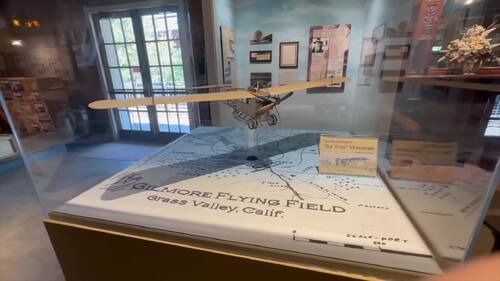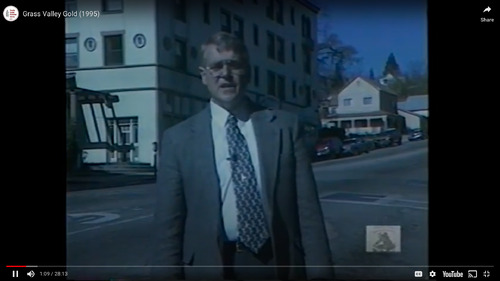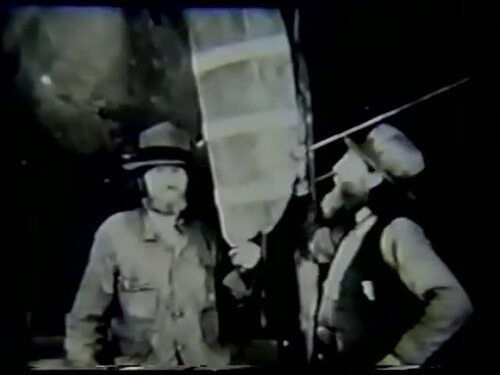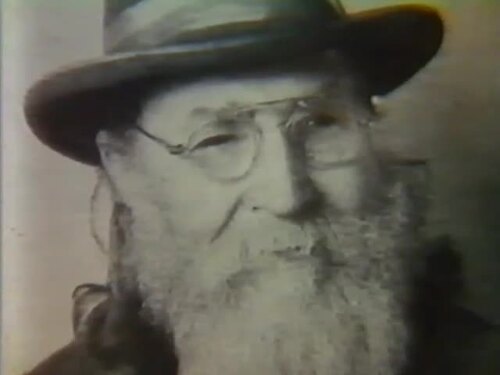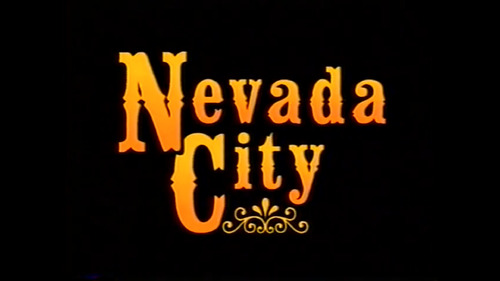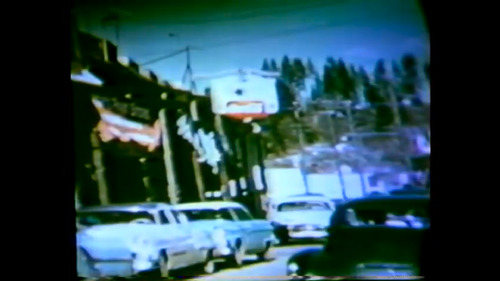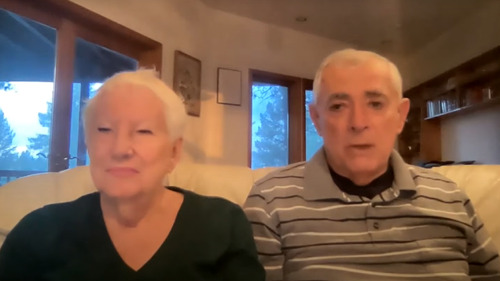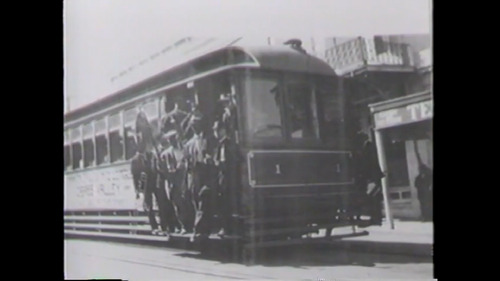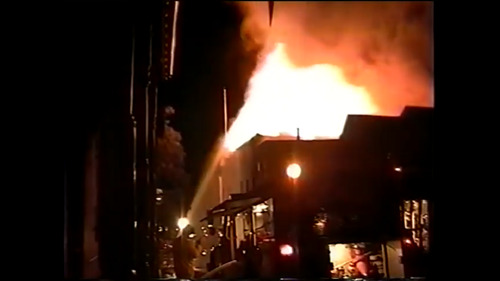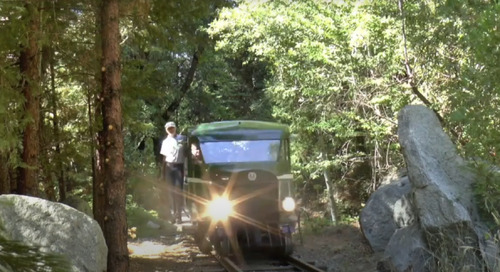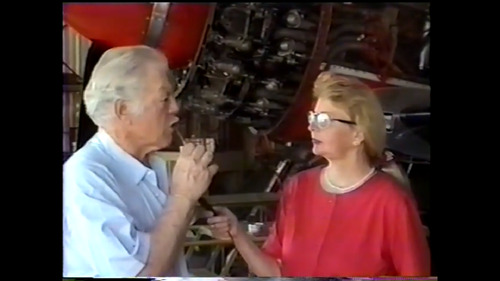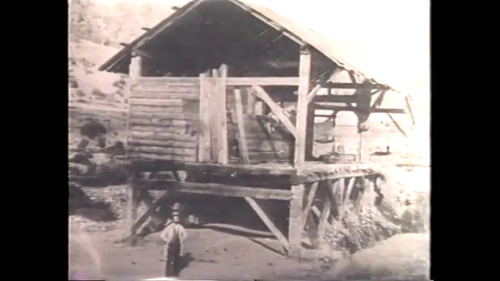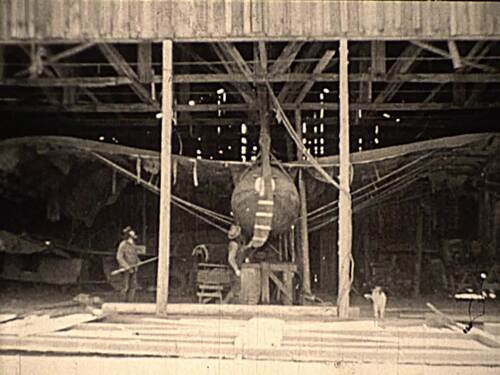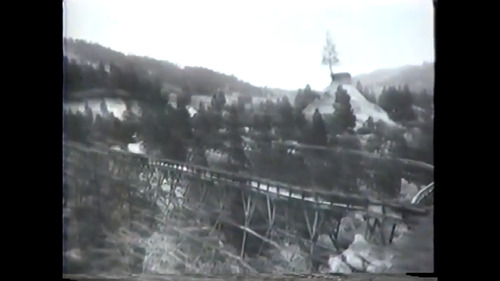Enter a name, company, place or keywords to search across the Nevada County Historical Archive's thousands of pages of online items and thousands of index records. Then click "Search" (or hit Enter).
All Items > Videos > Documentaries > Finding Guide
Finding Guide for "Documentaries" (29 images in 15 items)
Did Lyman Gilmore Fly Before the Wright Brothers?
Presenter: History Hunters
The History Hunters video explores the local legend of Lyman Gilmore, who some believe flew a powered airplane before the Wright Brothers in Grass Valley, California. Gilmore supposedly made his first flight on May 15, 1902, with a steam-powered engine. However, the only record of this event, his flight logs, was allegedly lost in a 1935 hangar fire. Gilmore did not make his claim until 1935 when 10 individuals certified his flight. Despite the lack of concrete proof, the community honors him, naming an elementary school and featuring aeronautics symbols after him. The transcript also covers a visit to the Nevada County Railroad Museum, where a model of Gilmore's 1912 Batwing monoplane and other artifacts related to him were found. The video questions whether Gilmore was a dreamer or an aviation pioneer, leaving the viewer to decide.
# of Slides/Images: 4
Download PDF: User Login Required
User Login Required
Download OCR Text: User Login Required
User Login Required
Link: https://archive.nevadacountyhistory.org/search/?Id=20358
The History Hunters video explores the local legend of Lyman Gilmore, who some believe flew a powered airplane before the Wright Brothers in Grass Valley, California. Gilmore supposedly made his first flight on May 15, 1902, with a steam-powered engine. However, the only record of this event, his flight logs, was allegedly lost in a 1935 hangar fire. Gilmore did not make his claim until 1935 when 10 individuals certified his flight. Despite the lack of concrete proof, the community honors him, naming an elementary school and featuring aeronautics symbols after him. The transcript also covers a visit to the Nevada County Railroad Museum, where a model of Gilmore's 1912 Batwing monoplane and other artifacts related to him were found. The video questions whether Gilmore was a dreamer or an aviation pioneer, leaving the viewer to decide.
# of Slides/Images: 4
Download PDF:
Download OCR Text:
Citation:
Hunters, History, "Did Lyman Gilmore Fly Before the Wright Brothers?"
Documentaries. Searls Historical Library, https://archive.nevadacountyhistory.org/search/?Id=20358
Documentaries. Searls Historical Library, https://archive.nevadacountyhistory.org/search/?Id=20358
Link: https://archive.nevadacountyhistory.org/search/?Id=20358
Grass Valley Gold
Grass Valley, California, nestled in the Sierra Nevada foothills, was once a central hub for gold mining in the United States. Its transformation from a rest stop for weary travelers to a booming mining town began with the discovery of gold-filled quartz in 1850. This revelation led to the development of hard rock mining techniques, which revolutionized the industry. The town's rich history is reflected in its landmarks, including Mill Street, where miners once processed stolen high-grade ore under the cover of darkness, and the homes of famous figures like Lola Montez and Lotta Crabtree. The growth of the mining industry also spurred the development of essential infrastructure, such as churches, schools, and hotels. The Holbrooke Hotel, in particular, thrived during the Great Depression due to the increased demand for gold. Nevada County's mining success was further solidified by the Empire, North Star, and Idaho Maryland mines, which were among the richest in the state. The mines' operations led to numerous innovations in mining technology and transportation, including the use of Cornish pumps, pneumatic rock drills, and the construction of the Nevada County narrow gauge railroad. The legacy of the mines extends beyond their economic impact, as they also played a crucial role in the development of the local community, contributing to the establishment of schools, parks, and hospitals. Despite the closure of the mines in the mid-20th century, their historical significance and the potential for future gold extraction continue to shape the identity of Grass Valley today.
Created: May 14, 1995
# of Slides/Images: 1
Download PDF: User Login Required
User Login Required
Download OCR Text: User Login Required
User Login Required
Link: https://archive.nevadacountyhistory.org/search/?Id=1822
Created: May 14, 1995
# of Slides/Images: 1
Download PDF:
Download OCR Text:
Citation:
"Grass Valley Gold"
Documentaries, May 14, 1995. Searls Historical Library, https://archive.nevadacountyhistory.org/search/?Id=1822
Documentaries, May 14, 1995. Searls Historical Library, https://archive.nevadacountyhistory.org/search/?Id=1822
Link: https://archive.nevadacountyhistory.org/search/?Id=1822
In Search of Lyman Gilmore
Presenter: Lyman Gilmore School
A group of students at Lyman Gilmore School is researching the school's namesake, Lyman Gilmore, an aviator and inventor. They are interviewing people who knew him and creating a film about his life. Gilmore was born in 1874 and claimed to have built and flown a steam-powered airplane in 1902, before the Wright Brothers. He also built the first commercial airfield in the U.S. in 1910. A 1935 fire destroyed his planes and evidence of his flights. People who knew him shared stories about his personality, his financial struggles, and his personal life, including a lost love. He later had a stroke and died in 1951. The students are exploring Gilmore's old airfield and runway, and there is a fictional scene where they meet Gilmore. They plan to continue their research beyond the current school year, utilizing local historical resources.
# of Slides/Images: 5
Download PDF: User Login Required
User Login Required
Download OCR Text: User Login Required
User Login Required
Link: https://archive.nevadacountyhistory.org/search/?Id=20359
A group of students at Lyman Gilmore School is researching the school's namesake, Lyman Gilmore, an aviator and inventor. They are interviewing people who knew him and creating a film about his life. Gilmore was born in 1874 and claimed to have built and flown a steam-powered airplane in 1902, before the Wright Brothers. He also built the first commercial airfield in the U.S. in 1910. A 1935 fire destroyed his planes and evidence of his flights. People who knew him shared stories about his personality, his financial struggles, and his personal life, including a lost love. He later had a stroke and died in 1951. The students are exploring Gilmore's old airfield and runway, and there is a fictional scene where they meet Gilmore. They plan to continue their research beyond the current school year, utilizing local historical resources.
# of Slides/Images: 5
Download PDF:
Download OCR Text:
Citation:
School, Lyman Gilmore, "In Search of Lyman Gilmore"
Documentaries. Searls Historical Library, https://archive.nevadacountyhistory.org/search/?Id=20359
Documentaries. Searls Historical Library, https://archive.nevadacountyhistory.org/search/?Id=20359
Link: https://archive.nevadacountyhistory.org/search/?Id=20359
KCRA Channel 3 Segment on Lyman Gilmore
This is a KCRA Channel 3 history segment called "On The Go" with John Gibson about Lyman Gilmore, an aviation pioneer in Grass Valley, California. Lyman Gilmore built an aerodrome and several airplanes in the early 1900s. He may have flown one of his aircraft in 1904, witnessed by a teenager named Charles Harris. Gilmore also claimed to have flown a steam-powered glider in 1902, before the Wright Brothers. A teacher named Stephen Barber researched Gilmore and uncovered many of his writings and designs. Gilmore was a gold miner but dedicated much time to designing airplanes. In the 1920s, a film crew documented Gilmore and his brother showcasing one of their aircraft. A fire later destroyed the hangar, airplanes, and many of Gilmore's papers in 1934. Gilmore died shortly after being hospitalized.
# of Slides/Images: 3
Download PDF: User Login Required
User Login Required
Download OCR Text: User Login Required
User Login Required
Link: https://archive.nevadacountyhistory.org/search/?Id=20350
# of Slides/Images: 3
Download PDF:
Download OCR Text:
Citation:
"KCRA Channel 3 Segment on Lyman Gilmore"
Documentaries. Searls Historical Library, https://archive.nevadacountyhistory.org/search/?Id=20350
Documentaries. Searls Historical Library, https://archive.nevadacountyhistory.org/search/?Id=20350
Link: https://archive.nevadacountyhistory.org/search/?Id=20350
Nevada City - Queen of the Gold Rush by Heather MacDonald
This documentary explores the history of Nevada City, California, a prominent city during the Gold Rush era. It begins by describing the initial discovery of gold in California by James Marshall in 1848, which led to a massive influx of prospectors. Nevada City, initially known as Deer Creek Dry Diggins, quickly became a central hub for mining activity due to its rich gold deposits. The documentary details the challenges faced by early miners, including the transition from placer mining to more complex techniques like hydraulic mining. It highlights the contributions of individuals like E.E. Matteson and Eli Miller, who developed innovative methods for gold extraction. The narrative also touches upon the transformation of Nevada City into a bustling town with a diverse population, including a significant Chinese community. The establishment of essential infrastructure, such as the Nevada County Narrow Gauge Railroad, further solidified the city's importance. The documentary concludes by emphasizing Nevada City's enduring legacy as a well-preserved example of Gold Rush-era architecture and its continued efforts to honor its historical past.
Created: May 14, 1999
# of Slides/Images: 1
Download PDF: User Login Required
User Login Required
Download OCR Text: User Login Required
User Login Required
Link: https://archive.nevadacountyhistory.org/search/?Id=1824
Created: May 14, 1999
# of Slides/Images: 1
Download PDF:
Download OCR Text:
Citation:
"Nevada City - Queen of the Gold Rush by Heather MacDonald"
Documentaries, May 14, 1999. Searls Historical Library, https://archive.nevadacountyhistory.org/search/?Id=1824
Documentaries, May 14, 1999. Searls Historical Library, https://archive.nevadacountyhistory.org/search/?Id=1824
Link: https://archive.nevadacountyhistory.org/search/?Id=1824
Nevada County - Magic of the Land by Stan Hall
The American River in California was the site of a gold discovery in 1848 that sparked a massive influx of prospectors and transformed the region. Nevada City, with its historic buildings like the City Museum and the National Hotel, became a central hub in the Northern Mine area. Grass Valley, another prominent mining town, owes its growth to the discovery of gold-filled quartz by George Knight. The mines in Grass Valley and Nevada County produced immense wealth and led to innovations in mining technology. The region also boasts a rich history beyond mining, with figures like Lola Montez and Lotta Crabtree leaving their mark. Transportation routes, including stagecoach lines and toll roads, played a crucial role in connecting the mining communities. Remnants of the mining era, such as abandoned buildings and equipment, can still be found throughout the area. Despite the decline of mining, towns like Grass Valley continue to thrive, preserving their historical legacy while embracing modernity. The enduring beauty of the Sierra Nevada foothills, with its rushing streams and picturesque landscapes, further adds to the allure of this region steeped in gold rush history.
Created: May 14, 2025
# of Slides/Images: 1
Download PDF: User Login Required
User Login Required
Download OCR Text: User Login Required
User Login Required
Link: https://archive.nevadacountyhistory.org/search/?Id=1826
Created: May 14, 2025
# of Slides/Images: 1
Download PDF:
Download OCR Text:
Citation:
"Nevada County - Magic of the Land by Stan Hall"
Documentaries, May 14, 2025. Searls Historical Library, https://archive.nevadacountyhistory.org/search/?Id=1826
Documentaries, May 14, 2025. Searls Historical Library, https://archive.nevadacountyhistory.org/search/?Id=1826
Link: https://archive.nevadacountyhistory.org/search/?Id=1826
Nevada County Ghost Towns Video with Bernie Zimmerman
Grace Suarez, publisher of UBET Press, interviews Bernie Zimmerman, a retired federal magistrate judge and author of "Ghost Towns of Nevada County." Zimmerman defines a ghost town as a once-settled community that has lost most of its population and buildings, focusing on former mining communities in Nevada County. He explains that the book includes introductory material on mining, maps, photographs, and map links for each town. Zimmerman's interest in ghost towns began when he moved to Yuba and became fascinated by its history. He researched and wrote histories for 18 ghost towns, many of which are on Wikipedia. During the pandemic, he compiled these histories into a book. Zimmerman shares interesting stories behind town names like Gougeye, Blue Tent, and Cherokee, highlighting the influence of the post office on town names. He also discusses his favorite ghost town, Meadow Lake, and the environmental impact of hydraulic mining that led to the decline of many towns. Zimmerman plans to expand the book with more research on ghost towns in the San Juan Ridge, Chalk Bluff, Washington area, and eastern Nevada County. The book is available for free on Apple Books and as a PDF on the UBET Press website.
# of Slides/Images: 1
Download PDF: User Login Required
User Login Required
Download OCR Text: User Login Required
User Login Required
Link: https://archive.nevadacountyhistory.org/search/?Id=1825
# of Slides/Images: 1
Download PDF:
Download OCR Text:
Citation:
"Nevada County Ghost Towns Video with Bernie Zimmerman"
Documentaries. Searls Historical Library, https://archive.nevadacountyhistory.org/search/?Id=1825
Documentaries. Searls Historical Library, https://archive.nevadacountyhistory.org/search/?Id=1825
Link: https://archive.nevadacountyhistory.org/search/?Id=1825
Nevada County Narrow Gauge Railroad
The Nevada County Narrow Gauge Railroad, a 22-mile short line, played a vital role in the development of Nevada County, California, during the Gold Rush era. Built without government subsidies, the railroad facilitated the transportation of goods, including gold shipments worth over a quarter of a billion dollars, between the mines and the Transcontinental Railhead at Colfax. The railroad's construction, spearheaded by local leaders like Judge Niall Searle and John Coleman, began in Colfax in 1875 and reached Nevada City in 1876. The route featured several impressive wooden trestles, including the Bear River Bridge, the highest railroad bridge in California at the time. The railroad faced challenges, such as the decline of hydraulic mining and competition from improved roads and trucks, leading to its eventual closure and sale for scrap metal in 1940. However, its legacy lives on through the efforts of organizations like the Nevada County Historical Society and the Grass Valley Video History Museum, which preserve artifacts and share the story of this once-vital transportation link.
Created: May 14, 1997
# of Slides/Images: 2
Download PDF: User Login Required
User Login Required
Download OCR Text: User Login Required
User Login Required
Link: https://archive.nevadacountyhistory.org/search/?Id=1827
Created: May 14, 1997
# of Slides/Images: 2
Download PDF:
Download OCR Text:
Citation:
"Nevada County Narrow Gauge Railroad"
Documentaries, May 14, 1997. Searls Historical Library, https://archive.nevadacountyhistory.org/search/?Id=1827
Documentaries, May 14, 1997. Searls Historical Library, https://archive.nevadacountyhistory.org/search/?Id=1827
Link: https://archive.nevadacountyhistory.org/search/?Id=1827
Nevada County Traction Company - Electric Trolley(March 3, 2000)
This documentary describes the history of the Nevada County Traction Company trolley line that ran between Nevada City and Grass Valley, California from 1901 to 1924. The narrative follows the trolley's route, highlighting key landmarks and obstacles encountered along the way, such as the need to reinforce the plaza bridge in Nevada City due to weight concerns. The trolley faced challenges, including limited power within Nevada City limits and steep grades that sometimes required passengers to disembark and push. The route passed through areas that have since been transformed by the construction of freeways, with former stops and depots replaced by modern businesses and infrastructure. The trolley's decline was attributed to harsh winter weather and the growing popularity of automobiles, leading to its eventual closure in 1924. Remnants of the trolley line, like the car barn in Grass Valley, can still be found, serving as reminders of this bygone era of transportation in Nevada County.
Created: December 31, 1969
# of Slides/Images: 1
Download PDF: User Login Required
User Login Required
Download OCR Text: User Login Required
User Login Required
Link: https://archive.nevadacountyhistory.org/search/?Id=1828
Created: December 31, 1969
# of Slides/Images: 1
Download PDF:
Download OCR Text:
Citation:
"Nevada County Traction Company - Electric Trolley(March 3, 2000)"
Documentaries, December 31, 1969. Searls Historical Library, https://archive.nevadacountyhistory.org/search/?Id=1828
Documentaries, December 31, 1969. Searls Historical Library, https://archive.nevadacountyhistory.org/search/?Id=1828
Link: https://archive.nevadacountyhistory.org/search/?Id=1828
Rebuilding the Heart of a City by Tintle, Inc
In this documentary, Gary Tintle recounts in 2003 the rebuilding of the Elks Building in Nevada City after it was destroyed in a fire. He describes the challenges faced during the demolition and reconstruction, including a complex foundation system due to unsuitable soil conditions. Tintle emphasizes the community's support and the collaboration between various teams, including architects, engineers, and subcontractors. He highlights the use of local resources, such as reclaimed bricks, and the commitment to preserving the building's historical character while incorporating modern safety features. The project faced numerous obstacles, including logistical issues and the need to adhere to strict building codes and regulations. Despite these challenges, Tintle expresses his satisfaction with the final result, describing the building as a beautiful and well-constructed testament to the resilience and collaborative spirit of the Nevada City community.
Created: May 14, 2025
# of Slides/Images: 1
Download PDF: User Login Required
User Login Required
Download OCR Text: User Login Required
User Login Required
Link: https://archive.nevadacountyhistory.org/search/?Id=1829
Created: May 14, 2025
# of Slides/Images: 1
Download PDF:
Download OCR Text:
Citation:
"Rebuilding the Heart of a City by Tintle, Inc"
Documentaries, May 14, 2025. Searls Historical Library, https://archive.nevadacountyhistory.org/search/?Id=1829
Documentaries, May 14, 2025. Searls Historical Library, https://archive.nevadacountyhistory.org/search/?Id=1829
Link: https://archive.nevadacountyhistory.org/search/?Id=1829
Riding the Railbus - Nevada County Railroad Museum
Nevada City Railroad Museum - Riding the Railbus!
# of Slides/Images: 1
Download PDF: User Login Required
User Login Required
Download OCR Text: User Login Required
User Login Required
Link: https://archive.nevadacountyhistory.org/search/?Id=1830
# of Slides/Images: 1
Download PDF:
Download OCR Text:
Citation:
"Riding the Railbus - Nevada County Railroad Museum"
Documentaries. Searls Historical Library, https://archive.nevadacountyhistory.org/search/?Id=1830
Documentaries. Searls Historical Library, https://archive.nevadacountyhistory.org/search/?Id=1830
Link: https://archive.nevadacountyhistory.org/search/?Id=1830
Sierra Treasures #5 Jim Flannigan at Auburn Airport and Bonnie Palmer about Lyman Gilmore
In the first section, an interviewer talks with Jim Flanagan, a mechanic at the Auburn Airport, about a plane he's been working on for ten years. Flanagan discusses the plane's history, including a crash that required an engine replacement. He explains that the current engine is powerful and reliable, but also expensive to maintain. Flanagan expresses confidence in the plane's safety, though he admits he would need a refresher course before flying it himself. The conversation also touches on the history of aviation, with Flanagan recalling the affordability of surplus planes after World War II. He contrasts this with the high cost of modern aircraft parts, emphasizing the challenges of maintaining older planes.
In the second section, the interviewer speaks with Bonnie Palmer about her fascination with Lyman Gilmore, a pioneer aviator from Grass Valley. Palmer, a former teacher, describes her extensive research on Gilmore, driven by a desire to document his accomplishments and contributions to aviation. She shares newspaper clippings and other historical records that highlight Gilmore's early flights and his innovative ideas. Palmer emphasizes Gilmore's passion for aviation and his concern for the environment, portraying him as a visionary ahead of his time. The conversation also touches on the challenges Gilmore faced, including setbacks with his early aircraft and the theft of his gyroscopic equipment. Palmer's dedication to preserving Gilmore's legacy is evident throughout the interview.
# of Slides/Images: 1
Download PDF: User Login Required
User Login Required
Download OCR Text: User Login Required
User Login Required
Link: https://archive.nevadacountyhistory.org/search/?Id=1831
In the second section, the interviewer speaks with Bonnie Palmer about her fascination with Lyman Gilmore, a pioneer aviator from Grass Valley. Palmer, a former teacher, describes her extensive research on Gilmore, driven by a desire to document his accomplishments and contributions to aviation. She shares newspaper clippings and other historical records that highlight Gilmore's early flights and his innovative ideas. Palmer emphasizes Gilmore's passion for aviation and his concern for the environment, portraying him as a visionary ahead of his time. The conversation also touches on the challenges Gilmore faced, including setbacks with his early aircraft and the theft of his gyroscopic equipment. Palmer's dedication to preserving Gilmore's legacy is evident throughout the interview.
# of Slides/Images: 1
Download PDF:
Download OCR Text:
Citation:
"Sierra Treasures #5 Jim Flannigan at Auburn Airport and Bonnie Palmer about Lyman Gilmore"
Documentaries. Searls Historical Library, https://archive.nevadacountyhistory.org/search/?Id=1831
Documentaries. Searls Historical Library, https://archive.nevadacountyhistory.org/search/?Id=1831
Link: https://archive.nevadacountyhistory.org/search/?Id=1831
The Forty-Niners and the California Gold Rush by Brazos Productions
This documentary narrates the California Gold Rush, triggered by James Marshall's discovery of gold in 1848. The news spread rapidly, causing a mass migration of people from various backgrounds and professions to California. The gold rush significantly impacted the lives of individuals like John Sutter, whose sawmill and agricultural empire were disrupted by the influx of miners, and James Marshall himself, who faced numerous setbacks and ultimately died penniless. The documentary also highlights the experiences of gold seekers, including those who traveled by sea and overland, facing hardships and uncertainties in their pursuit of wealth. It also touches on the social and environmental consequences of the gold rush, such as conflicts between miners and Native Americans, the rise of boomtowns, and the transformation of the California landscape due to extensive mining operations. Despite the challenges and complexities, the California Gold Rush remains a significant chapter in American history, shaping the development of the state and leaving a lasting legacy.
Created: December 6, 1993
# of Slides/Images: 1
Download PDF: User Login Required
User Login Required
Download OCR Text: User Login Required
User Login Required
Link: https://archive.nevadacountyhistory.org/search/?Id=1832
Created: December 6, 1993
# of Slides/Images: 1
Download PDF:
Download OCR Text:
Citation:
"The Forty-Niners and the California Gold Rush by Brazos Productions"
Documentaries, December 6, 1993. Searls Historical Library, https://archive.nevadacountyhistory.org/search/?Id=1832
Documentaries, December 6, 1993. Searls Historical Library, https://archive.nevadacountyhistory.org/search/?Id=1832
Link: https://archive.nevadacountyhistory.org/search/?Id=1832
The Gilmore Brothers' Airship
Presenter: Pathé News
This silent film reel from Pathe News, possibly from 1931, is about the Gilmore brothers and their airship. The footage shows the brothers opening their dusty hangar to reveal an old aircraft they built years ago. They examine the plane, showing its decayed bat-like cloth wings, turning the propeller, and testing support struts. One brother brushes dust off the fuselage and wings. The plane appears untouched for over 20 years. The brothers display design blueprints and an old photograph of the plane. They climb into the fuselage of the old aircraft, that may or may not have ever flown. The footage seems to coincide with when the brothers first made their claim about achieving the first controlled flight, years before the Wright Brothers. Finally they posed for the newsreel camera. The original film reel is held at Searls Historical Library.
Created: May 14, 2025
# of Slides/Images: 4
Download PDF: User Login Required
User Login Required
Download OCR Text: User Login Required
User Login Required
Link: https://archive.nevadacountyhistory.org/search/?Id=20360
This silent film reel from Pathe News, possibly from 1931, is about the Gilmore brothers and their airship. The footage shows the brothers opening their dusty hangar to reveal an old aircraft they built years ago. They examine the plane, showing its decayed bat-like cloth wings, turning the propeller, and testing support struts. One brother brushes dust off the fuselage and wings. The plane appears untouched for over 20 years. The brothers display design blueprints and an old photograph of the plane. They climb into the fuselage of the old aircraft, that may or may not have ever flown. The footage seems to coincide with when the brothers first made their claim about achieving the first controlled flight, years before the Wright Brothers. Finally they posed for the newsreel camera. The original film reel is held at Searls Historical Library.
Created: May 14, 2025
# of Slides/Images: 4
Download PDF:
Download OCR Text:
Citation:
News, Pathé, "The Gilmore Brothers' Airship"
Documentaries, May 14, 2025. Searls Historical Library, https://archive.nevadacountyhistory.org/search/?Id=20360
Documentaries, May 14, 2025. Searls Historical Library, https://archive.nevadacountyhistory.org/search/?Id=20360
Link: https://archive.nevadacountyhistory.org/search/?Id=20360
Waters of Gold
This documentary describes the history of hydraulic mining in Nevada County, California. It begins by describing the early days of placer mining, where miners used picks, shovels, and gold pans to extract gold from rivers and streams. As the easily accessible gold was depleted, miners turned to hydraulic mining, which used high-pressure water jets to dislodge gold-bearing gravel. This method, while efficient, caused significant environmental damage due to the large amounts of debris it released into rivers and streams. The documentary details the conflict between hydraulic miners and downstream farmers, who suffered from the pollution and flooding caused by mining debris. Legal battles ensued, culminating in a landmark court decision in 1884 that effectively banned hydraulic mining. The documentary concludes by discussing the lasting impact of hydraulic mining on the region and the ongoing efforts to balance the economic benefits of mining with environmental concerns.
# of Slides/Images: 2
Download PDF: User Login Required
User Login Required
Download OCR Text: User Login Required
User Login Required
Link: https://archive.nevadacountyhistory.org/search/?Id=1833
# of Slides/Images: 2
Download PDF:
Download OCR Text:
Citation:
"Waters of Gold"
Documentaries. Searls Historical Library, https://archive.nevadacountyhistory.org/search/?Id=1833
Documentaries. Searls Historical Library, https://archive.nevadacountyhistory.org/search/?Id=1833
Link: https://archive.nevadacountyhistory.org/search/?Id=1833




